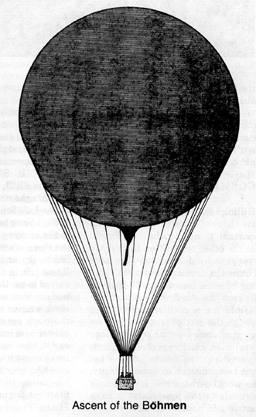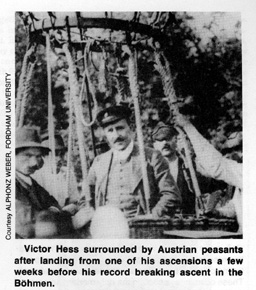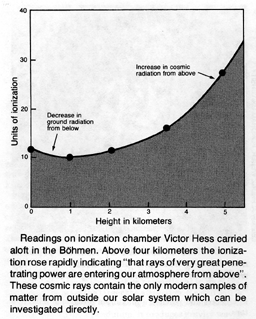The linden and willow-lined meadow near Aussig in northern Bohemia had been active since the earliest light of morning. Nearby the river Elbe flowed northward to the Erz mountains whose azure peaks shimmered in the distance against a cloudless sky. Now a few hours after dawn a huge orange and black balloon towered majestically above the meadow's grassy expanse, the low slanting rays of the sun glinting off its rounded dome. Named the Böhmen (German for Bohemia) it towered twelve stories high. Nudged by an almost imperceptible breeze, the big bag tugged impatiently on its ropes. Members of the Austrian Aeroclub moved with a well-practiced efficiency making final preparations for its ascension but one could detect a feeling of excitement in the air for this was no ordinary flight.
It was Wednesday the seventh of August, 1912, and today the Böhmen, with its lifting power of two tons, was to carry Herr Doktor Victor Hess and a load of his apparatus on a high altitude flight. Hess, 29, taught physics at an academy
of veterinary medicine in Vienna. He was already aboard checking his equipment. The flight meteorologist, Ernst Wolf, was also in the rope-festooned basket adjusting his barometer.
Inflation was complete and the Aeroclub members disconnected hoses from hydrogen tanks on some wagons nearby. Captain Wolfgang Hoffory, the pilot, walked around the outside of the basket inspecting the sand-filled ballast bags hanging from its perimeter. Shouting final orders to the ground crew he swung effortlessly aboard. He was a veteran of many ascensions and had, in fact, piloted Dr. Hess on a number of flights during the previous months. But none went as high as he hoped to rise today.
 At twelve minutes past six Captain Hoffory gave the command to cast off and slowly the great rotund Böhmen rose gracefully and silently into the sky seeking the source of a strange radiation.
At twelve minutes past six Captain Hoffory gave the command to cast off and slowly the great rotund Böhmen rose gracefully and silently into the sky seeking the source of a strange radiation.
For many years scientists had puzzled over the fact that an electroscope gradually lost its charge even though it was carefully insulated. Electroscopes had come into wide use after the discovery of radioactivity by Antoine Becquerel of France in 1896. A typical electroscope consists of two leaves of gold foil suspended from an insulated electrode or metal rod in a metal container with glass window. When given an electric charge, as from a rubber comb rubbed with a flannel cloth, the leaves spring apart due to the repulsion of their like charges. Radiation from radioactive material brought near the electroscope penetrates the container producing ions or charged particles in the air inside which discharges the leaves and causes them to drop. What the scientists had noted was that even in the absence of any known radioactive material, the leaves would gradually drop, suggesting some unknown radiation. It was suspected, and later confirmed, that the radiation came at least in part from the weak radioactivity of substances present near the surface of the earth.
By measuring the rate at which the leaves collapse one can determine the strength of the ionizing radiation. If the pressure of the air in the container enclosing two leaves is increased, the electroscope becomes more sensitive and these so-called ionization chambers were carried to the top of the Eiffel tower and aloft in balloons to determine if the radiation decreased with height above the ground but the results were inconclusive.
Victor Hess had wondered if the unknown radiation might come from outside the earth, perhaps from the sun. With support from the Royal Vienna Academy of Science, he had embarked on a series of balloon ascensions at night, during the day and even one during an eclipse of the sun. From these he concluded that the sun was not the source of the mysterious ionizing radiation.
The flight today was the seventh in a series he had begun in April, 1912, and his aim today was to go much higher than he had before. The previous ascensions indicated that there was a small decrease in ionization going from the ground to heights of a few hundred meters due apparently to a reduced effect of the earth's radioactivity. However, with further increase in height up to 2000 meters the readings did not seem to change.
The Böhmen was now rising rapidly and catching a 30 kilometer per hour wind from the south, began to follow the
Elbe northward over the Bohemian countryside. Soon clouds appeared ahead. They were scattered, puffy, white cumulus clouds, all at the same altitude. The Böhmen climbed though them and now, looking down, they dotted the landscape like balls of cotton all the way to the horizon. Near Peterswalde the balloonists crossed into Saxony and smoke floating up lazily from the factories of Dresden appeared off to the west.
An hour after lift-off they were at 1600 meters and during the next two hours they rose to 3600 meters. The sun climbing in the east warmed the balloon increasing its lift so Captain Hoffory could conserve on the amount of sand ballast he had to release.
At 10:45 they attained 5350 meters, their maximum altitude, and Captain Hoffory pulled a valve to release some gas and start their gradual descent. Above them at about 6000 meters, there was now a thin filmy layer of strato-cirrus clouds through which the sun shone brightly.
Victor Hess had been busy from before lift off with his apparatus consisting of three ionization chambers and associated equipment. Each chamber was made of an air-tight, thick-walled metal cylinder the size of a two liter can with a small glass window for observing the electroscope leaves with the aid of a microscope. Hess took readings on all three instruments in rotation as the cold thin air of the high altitudes penetrated his clothing. He carefully recorded these values along with the barometric pressure readings, which indicated the altitude, as called out by Ernst Wolf.
On chamber number 2, which was rather typical of the three instruments, the ionization at the ground was about 12 units. At an altitude of 1000 meters it dropped to 10 but at 2000 meters the reading was up again to 12. At 3500 meters the ionization level had climbed to 15 and most startingly at 5000 meters it rose to 27 units or more than twice its value at the ground!
The descent was gradual, taking another two hours. On the way down Victor Hess continued to take readings which confirmed the ones he obtained on the ascent. At fifteen minutes past noon Captain Hoffory brought the Böhmen down in a pasture near a small village about 50 kilometers east of Berlin. They had been aloft six hours, traveled 200 kilometers and reached a maximum altitude of 5350 meters.
"Rays of very great penetrating power are entering our atmosphere from above."
 Victor Hess had been so preoccupied with his instruments and recording of the data that the full import of his results did not strike home until after the flight when he had the time to analyze the data carefully. But then there was no doubt. The increase with altitude demonstrated that it must be caused from above. The atmosphere was like an absorbing blanket. The higher one rose through it the stronger the radiation from above became. In his report published later that year in the Physikalisches Zeitschrift he stated,
Victor Hess had been so preoccupied with his instruments and recording of the data that the full import of his results did not strike home until after the flight when he had the time to analyze the data carefully. But then there was no doubt. The increase with altitude demonstrated that it must be caused from above. The atmosphere was like an absorbing blanket. The higher one rose through it the stronger the radiation from above became. In his report published later that year in the Physikalisches Zeitschrift he stated,
"The results of the observations indicate that rays of very great penetrating power are entering our atmosphere from above."
During the next two years confirmation of Hess' results came from further balloon flights by Werner Kohlhörster which culminated in an ascension to 9300 meters from Bitterfield, near Leipsig, Germany on June 28, 1914. Rising above the height Hess had reached, Kohlhörster found that the ionization continued to increase at an increasing rate. But not every one was convinced by Hess' and Kohlörster's observations and a violent controversy ensued in scientific circles which raged for a dozen years.
On the same day as Kohlhörster's 9300 meter flight Archduke Francis Ferdinand, heir to the throne of Austria-Hungary, was assassinated and soon armies were on the march as Europe exploded and plunged into World War I. Strange radiations penetrating the earth's atmosphere from above now seemed of little consequence and further balloon measurements would have to wait.
 Eventually Hess' results gained acceptance and the radiations he had discovered coming from beyond the earth were named cosmic rays. Perhaps, it was thought, they might be electromagnetic waves like x-rays, only of a more penetrating kind. Subsequently, however, they were shown to be material particles and not waves: protons (hydrogen atom nuclei) and nuclei of heavier atoms to at least uranium, often with enormous energy and penetrating power, which bombard the earth relentlessly. In 1936, Victor Hess received the Nobel prize for his discovery of cosmic rays.
Eventually Hess' results gained acceptance and the radiations he had discovered coming from beyond the earth were named cosmic rays. Perhaps, it was thought, they might be electromagnetic waves like x-rays, only of a more penetrating kind. Subsequently, however, they were shown to be material particles and not waves: protons (hydrogen atom nuclei) and nuclei of heavier atoms to at least uranium, often with enormous energy and penetrating power, which bombard the earth relentlessly. In 1936, Victor Hess received the Nobel prize for his discovery of cosmic rays.
The origin of cosmic rays is uncertain but it is presumed that many are generated during violent events, such as stellar explosions within our galaxy. It is entirely possible that a proton striking the earth today was shot out from the Crab nebula, the exploded star of 1054 A.D. In its long journey from the nebula, it has traveled at nearly the speed of light for thousands of years. Magnetic fields encountered along its way have deviated its path from a straight line, like cross-winds buffet a ship off course, so its direction on reaching the earth is not that of the Crab nebula. But this tiny particle is a messenger from a distant part of our galaxy with perhaps a fascinating tale to tell if it could.

Note: The term radioactivity came into use long before the word "radio" was coined. Radioactivity implies that a substance such as radium emits or radiates particles or very short electromagnetic waves called gamma rays. It does not mean that the substance emits radio waves which are very long wavelength electromagnetic waves. However, the similarity of the words leaves them open to confusion.
![[NAAPO Logo]](../../Images/NAAPOsm.jpg)
![[NAAPO Logo]](../../Images/NAAPOsm.jpg)